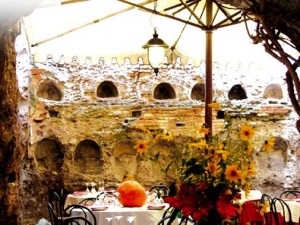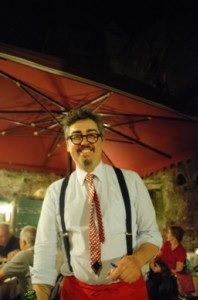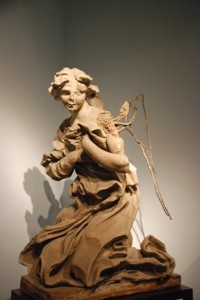When in Rome – we did as the tourists do. With our young children in tow, we spent unspeakably hot days touring the Forum and Coliseum; spent a morning in the Capitoline Museum and an afternoon on the Palatine Hill under the pines of Rome. Being raised in my father’s Italian-American hometown, every face seemed familiar to me – dark hair, big brown eyes, aquiline noses – all faces I grew up with. One reminded me of my childhood friend Gina, another of my Uncle Salvatore who everyone calls Tutti, and yet another of childhood neighbor – Tony M.

Returning to the font, I reveled in our cabdriver who spoke with his hands so much that he could moonlight as a sign-language translator. Passionately telling us stories as he swerved round corners and through changing traffic lights. Somehow, this master of the backstreets managed to get us from our hotel to the Vatican Museums without actually touching the steering wheel.
After that wild ride – we saw some of the greatest art that the West has to offer. Besotted on grandeur of the Botticelli, Da Vinci and Michelangelo in the collection, my favorite find was a temporary display of Bernini sculptural models for his angels in Saint Peter’s. These models had the same the same soft, beatific expressions as his finished marble masterpieces, the same verdant folds in the drapes of their clothes but they were rendered in clay, straw and wire. The straw that formed the base of the figures protruded in places where the clay had worn away like finite element models used by designers in today’s world. On some of the angels, the clay on the wings had long since crumbled – revealing the structural wires that lay beneath. Not a fallen angel, but a broken one. Not evil – these models were just a bit more mortal than his divine masterworks.
Food and the enjoyment of food is everywhere in Rome, form the wild figs growing along the city street side as a result to a carelessly thrown pith to an abundant fruit cart with offerings to cool you down on a summer’s day to fine dining from committed people who are passionate about food.
The great food-find of our trip to Rome was a restaurant out on the Old Via Appia – Hostaria Antiqua Roma. Not far from the San Callisto and San Sebastian Catacombs, it is a jewel of a restaurant not to be missed. My husband and I dined there to eat from its special Ancient Roman menu, but the dishes on the regular menu sampled by the kids were really phenomenal as well. The setting for summer dining is perhaps unique in the world, for when weather allows, guests dine outside surrounded by the walls of a Roman mausoleum that has been featured in several engravings by Piranesi in the late 18th century. My husband, the historian, was thrilled and amazed by this and kept on looking around and chuckling just a bit as he ate.

In addition to the fine food and the unique setting, the proprietor of this family establishment, Paolo Magnanimi, makes dining there a memorable experience. His attention to detail both in and out of the kitchen and the stories he regales you with make you feel more like a guest at his family’s table than a customer. The site was purchased by Paolo’s father, Massimo, in 1982 and the labors and love of their family have, over the years, turned the site from a “place abandoned by God and men” into a beautiful, welcoming and delicious place to dine.
Paolo’s personality and love of his work and restaurant shine though in conversation. Raised in the his family’s food and hospitality business, he likened the opening of the gate every evening to the rise of a stage curtain and his hosting and restaurant oversight duties to the performance of an actor. When touring us through the restaurant after the meal, Paolo told us that the first time the actor Harvey Keitel came to Hostaria Antiqua Roma that he thought, “It was like Jesus coming into Jerusalem.” The actor proceeded to come for dinner every night that week and by his last visit Paolo said Keitel “was like my uncle coming over to the house for dinner.”

For starters we had Antipasto Romano which featured wild-boar sausages, a roman mortadella, and sharp pecorino cheese. Included as part of this selection, we also had the Roman herbed olives (Epitryum Varium). This was served along with a Roman cheesebread called Libum di Catone, and an amazing spread made from Romano cheese and garlic called Moretum. Hearing about our love of food, we were also allowed to sample a delicious sweet and sour marinated eggplant that might be an adaptation of the classic Tybaris.
Wild boar is one of my favorite meats and I have had it in many European countries, Africa and Americas. Still the boar sausage served at Hostaria Antiqua Roma was unique and earthy with a robust peppered flavor and overtones of perhaps cinnamon and cloves with a bit of anise to lighten. It was also a flavorful companion to the sharp pecorino it was served with. The olives were adapted from a recipe in Cato’s On Agriculture (ca. 160 BCE) and had cumin and fennel seeds along with touches of cilantro and mint in the white vinegar and oil marinade. The bread served with these Ancient Roman delicacies was a libum made of a softer cheese – perhaps a farmer’s cheese or ricotta – flour and egg and seasoned with a bit of bay leaf, fennel seeds, salt and pepper. Traditionally, the Romans baked this bread on a sheet of bay leaves so that the flavor is lightly infused by the baking process making for a light biscuit or small loaf.
The star of the appetizer table was a simple moretum – a spread of garlic and grated hard cheese – like romano and a bit of olive oil for flavor and consistency. There was possibly the addition of a bit of salt, pepper and coriander seed, but if so they were only the most delicate addition to powerful ingredients that spoke for themselves quite well. Classical recipes for moretum often include the addition of a lot of herbs like cilantro, celery and rue, but these seemed to be absent in the version served at Hostaria Antiqua Roma – with no loss. On the tongue, the moretum had a flavor that started forcefully and mellowed as it spread. My husband and I struggled between the poles of personal desire and public politeness as we kindly bade each other to have some more of this delicious dish.
For main courses we had Paolo’s chicken with fish sauce – a recipe closely related to the Roman Pullum Frontonianum from Apicius‘ De Re Coquinaria, and a Ancient Roman lasagna which combined recipes for Lagane pasta and a Patina of meat, cheese, fennel and leeks. Despite its name, the chicken with fish sauce was a mild but flavorful roast chicken that was savory given the addition of garum fish sauce, grape syrup and ample portions of winter savory and ground black pepper. On the lighter side, coriander seed, dill and a splash of red wine vinegar brightened the dish.
Although delicious, I think in Roman times, the garum flavor of the chicken would have been more pronounced – partially because the Romans loved the flavor and partially because diners had the option to add mixtures of garum, wine, (sometime fruit) and herbs to their food as a table condiment called oenogarum. In conversation he told us that he used to make his own garum, but that he now uses off-the-shelf nuc mam imported from Asia. Although I understand the difficulties (primarily stink and time) of making garum, I think that this choice is a pity, because modern nuc mam has none of the wine, must and the selection of herbs such as oregano, coriander, mint, celery and pepper that Roman garum did.
The Roman lasagne served at Hostaria Antiqua Roma is nothing short of a miracle. Given how the modern dish is usually ladled with marinara sauce, we were both interested to see how the dish might have been made prior to contact with the New World and the spread of the tomato to the far corners of the globe. Roman pasta whether in sheets, strips or small shapes was fried and used to layer patina (as in the modern lasagna) or used to pickup and wrap food from a plate. Patina was any mixture made in layers and prepared in a dish called a “patina”. Some patinas were made from combinations of offal and spices; some were herbs, meats and vegetables; and still others had the addition of cheese or fruit. The patina that Paolo used for his lasagna was delicious and flavored with ground beef, grated romano cheese with a touch of ricotta, fennel, leeks, salt and pepper – and it was delicious. Interestingly, this dish was more like modern Greek “lasagnes” such as spanakotiropita, and pastitsio.
Full almost to bursting we shared a tiramisu that was made layered in a dish with generous amounts of cocoa powder on top – a delicious take on the traditional dessert and a wonderful way to end a truly memorable meal.
After our meal, Paolo toured us around the inside of the restaurant which is decorated in the rustic but beautiful manner of a country inn with wooden beams and warm, cozy colors. If not already evident – I highly recommend Hostaria Antiqua Roma. So when you are in Rome – you can eat as the Ancient Romans did. (Words by Laura Kelley; Photos of Gladiactors Arguing at the Coliseum Metro, Bernini – Broken Angel; and Paolo Magnanimi by Laura Kelley; Photo of Mausoleum Dining Area from Hostaria Antiqua Roma website.)
RECIPES
Libum Di Catone
2 cups ricotta
½ – 1 cup flour
1 egg
1 teaspoon salt
2-3 teaspoons fennel seeds (optional)
Directions
Mix cheese in a mortar. When you have made it smooth, knead the cheese into the flour. Add one egg and knead again. Add salt and fennel seeds if using and form one large loaf or smaller loaves. Place them on a bed of bay leaves and cook at 350 degrees for about 25-30 minutes for smaller buns and longer for a large loaf.
Epityrum Varium
3 ounces of whole green olives
3 ounces of whole black olives
1 teaspoon of cumin seeds
1/2 teaspoon of fennel seeds
1 medium bunch of cilantro leaves (25-30 sprigs)
A sprig of rue (or substitute arugula or cress)
2 or 3 springs of mint
2 tablespoons olive oil
3 tablespoons white wine vinegar
Directions
Buy pitted olives, or use olive pitter. Grind cumin and fennel seeds in spice grinder or a mortar and pestle. Finely chop the coriander, rue or substitute and mint. Roughly chop the olives, dress with olive oil and vinegar. Add the herbs. Toss ingredients together in a bowl. Add a drop more vinegar if desired. Serve with plenty of crusty bread.
Moretum
4-6 medium cloves garlic (more or less as desired)
1/2 pound Romano cheese, grated (could use parmesan)
½ teaspoon salt (or as desired)
2-3 teaspooons of fennel seeds, ground
3-4 tablespoons extra virgin olive oil (more as needed for consistency)
Directions
Grind garlic along with the salt in a mortar and pestle or food processor, and then add the grated Romano cheese and blend thoroughly. Add the olive oil as needed for the consistency of a smooth paste. Garlic Flavor will be less strong if it is allows to sit for several hours or overnight. Optional ingredients for this amount of moretum can also include: a small to medium bunch of cilantro, chopped; ¼ cup chopped celery and two tablespoons of young rue or fennel leaves. If herbs are added, the consistency will have to be adjusted with the addition of more olive oil. Serve room temperature or slightly cool.
Chicken with Fish Sauce
1 free-range chicken whole or in parts
3 tablespoons olive oil
3-4 leeks, chopped
3/4 cup garum or liquamen
¼ cup red wine vinegar
1/2 cup strong red wine
1 teaspoon fresh dill
1 teaspoon fresh savory
1 teaspoon ground coriander
1 small bunch cilantro, chopped (10-20 sprigs)
1/4 -1/2 cup defritum (thick grape syrup)
2-3 teaspoons ground black pepper
Directions
In a small bowl, combine the garum or liquamen, the red wine vinegar and the red wine. Whisk in the dill, savory and coriander and 1 teaspoon of the black pepper. Let sit for several hours or overnight until the spices permeate the liquid. Sauté the chicken until the skin starts to turn golden. When done, set aside. Spray or rub a baking dish and line with the leeks. Place the chicken on or above the leeks if using a baking rack. Pour the garum and spice mixture over the chicken. Place in preheated 350 degree oven for at least 1 – 1 -1/2 hours (baking times will vary with the size of the bird used). Baste and turn as necessary.
As the chicken is cooking, in a small saucepan, heat the grape juice to a boil to make the defritum. Use only 100% unsweetened grape juice. I prefer the juice of concord grapes, but use any type or mixture of dark grape juice you desire. Once boiled, reduce heat immediately and cook over low heat, stirring often, until the juice is reduced by at least half and is beginning to thicken. Continue cooking over low heat until a syrup is formed. be careful not to scorch or burn the syrup. When done remove from heat and set aside.
If leeks dry out, add a bit of water or broth to moisten along with a bit of unsalted butter. When the leeks are done, remove them from the pan and continue cooking the chicken.
When chicken is done, let it rest for 10 minutes and place it on the serving plate. If desired, place the chicken on a bed of leeks. Pour or baste the defritum over the chicken and season with freshly-ground pepper. If syrup has hardened while cooling, reheat over low heat to a spoonable or basteable consistency. Garnish with more freshly chopped cilantro.. (Words and Photos by Laura Kelley.)

